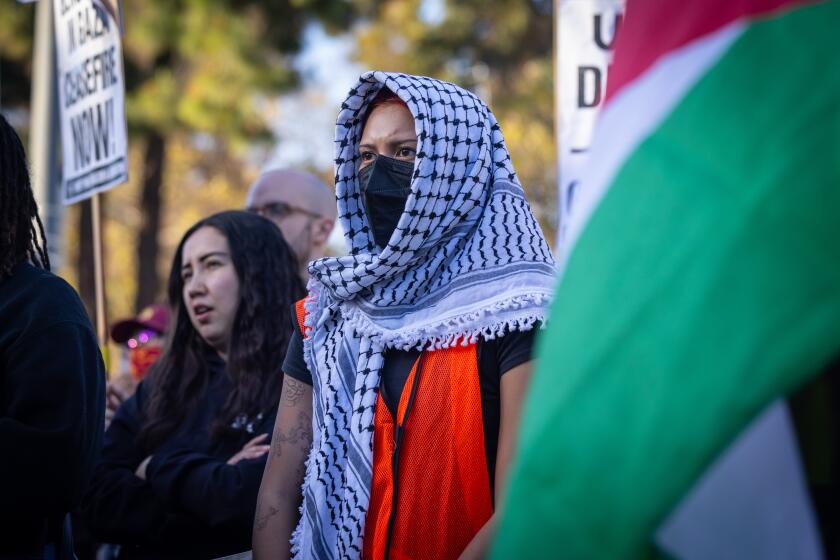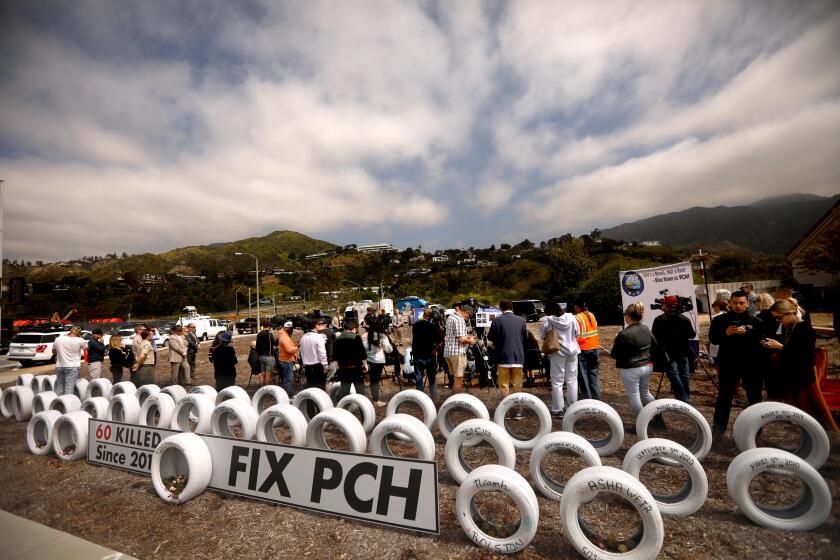‘Fingerprinting Night’ Keeps Sheriff’s Explorers Busy
It could have been the scene at any local bar on a Thursday night:
Neon lights atop a one-story building pierced an evening haze. Sonja South pushed through the building’s swinging doors, sidled up to a waist-high counter and pulled out a $5 bill and three ones from her wallet. She laid them on the counter and then rang an old-fashioned bell.
“I need to get fingerprinted,” she said.
This is the sheriff’s brand of happy hour: Fingerprinting Night.
From 6:30 to 8 p.m. Thursdays at the Altadena sheriff’s station, anyone can fill their fingertips with India ink and walk out with a copy of their prints for posterity.
From Aliso Viejo to West Hollywood, most sheriff’s stations will take fingerprints for a small fee. Some police departments provide the service too. At the Altadena sheriff’s station, Fingerprinting Night has been an institution since the late 1970s.
These days, it seems as if everyone requires a set of your digits: Prospective employers. Your child’s school, if you want to volunteer. And then there are professions that have long required fingerprints. Child care workers need them, as do journalists to receive press passes.
The Los Angeles County Sheriff’s Department doesn’t keep statistics on how many people request fingerprinting each year, but it’s estimated that each of the 20 stations in the county does 50 to 100 a month--that’s anywhere from 12,000 to 24,000 a year.
While many other law enforcement agencies have begun fingerprinting by computer on a sometimes costly system known as Live Scan, most sheriff’s stations make prints the old-fashioned way--with paper and ink.
On this evening in Altadena, eight local residents requested prints, including a paralegal seeking to become a process server, who would drive his prints to the county registrar in Norwalk the next day, and a computer programmer applying to be a Canadian resident, who had to send his prints to the FBI.
And although you wouldn’t have known it from the hustle and bustle that resembled a neighborhood Christmas party, this was a slow night for the young Sheriff’s Department Explorers who run Fingerprinting Night.
“I’ve heard stories of some Explorers doing 40 cards in a night,” said Jessica Quirol, 16, one of three Explorers--teenage trainees learning about the ins and outs of law enforcement--on duty.
At the Altadena station, fingerprinting is one of the Explorers’ main duties. “It allows us to not have to have deputy sheriffs working those positions,” Deputy Ray Harley said. “Instead, they can remain on the streets and in patrol cars.”
Jessica’s partner, Vahe Tchoukadarian, also 16, took South’s money, placing it in a rectangular money box, then slowly filled in a receipt in triplicate. The receipt, he told South, should be brought back if any problem arises.
South, who had just begun work at a day-care center, said she hoped there wouldn’t be a problem. Her prints were due a week later at her new employer’s office. “It’s a requirement to have fingerprinting done,” she said.
South said she had been through this process before while working at the Pasadena City College Child Development Center. She lamented that the state “couldn’t find my prints on record.”
Still, she said, $8 seemed not much to pay. Other agencies, such as nearby Pasadena City College, charge up to $100 for a Live Scan set of prints.
Once the money exchange was complete, South, with her 7-year-old daughter, Ebony, in tow, followed Jessica toward the back of the station, passing a caged chamber that once was the jail and now functions as a storage closet.
The fingerprinting room itself has all the charm of an unfinished garage. Boxes are stacked in one corner, and the printing board--a thick piece of glass--is affixed with duct tape to a sheet-metal counter top.
There’s a certain art to taking fingerprints, said Harley, who oversees Explorers at the Altadena and Crescenta Valley stations.
“The fingerprints must be rolled--not just pressing the finger straight down--in a manner that gets as much of the fingerprint as possible,” he said. “You have to be careful to use the right amount of pressure. If you press down too hard, you get smearing or the print could come out much too dark.”
It’s harder than it looks. “Advisors grade us on our cards,” Vahe said. “After the sixth one, your skills are fairly decent.”
Jessica shook her head a bit sheepishly. “It took me a few more cards,” she said. “I got smudges with the ink. You move or they move.”
To make a print, Jessica squeezes what looks like an oversized toothpaste tube, leaving a long black strip on the glass. She then spreads the ink evenly with a roller. She locks a piece of heavy card stock into a metal guide at the edge of the counter and carefully rolls the person’s fingers through the ink and onto the paper one by one.
The Sheriff’s Department does not keep a copy of the prints or log them into a database. It’s up to the people requesting them to forward the prints to the right agency or their employer.
Darron Whitaker, 33, brought his wife and son to Fingerprinting Night. The Whitakers are opening a day-care facility in their home and passed on an expensive Live Scan. This way “may take longer, but it’s worth it,” he said.
As Whitaker waited, South emerged from the station bathroom. Her fingerprinting done, she had scrubbed her fingertips with an astringent soap and clutched her set of prints in a paper towel. “How do I store it?” she asked, looking dubiously at the card.
“Just let it dry for 15 minutes,” Vahe told her. “Then it should be fine.”
More to Read
Start your day right
Sign up for Essential California for news, features and recommendations from the L.A. Times and beyond in your inbox six days a week.
You may occasionally receive promotional content from the Los Angeles Times.






